IDEX Online Research: August Polished Diamond Prices Up 2.8%
September 03, 07
Global demand for polished diamonds remained strong during August, pushing prices up solidly in the month. Despite summer vacations in several major diamond trading markets, which resulted in somewhat lower trading volume, polished diamond demand, especially for large high-quality stones, remained robust.
Polished diamond prices rose in August by 2.8 percent from August 2006. This is at the high end of the overall long term price inflation rate in the polished diamond industry, and is well above the average diamond price inflation rate for 2007. August’s polished diamond price increase was the second largest since the beginning of the year.
Polished diamond prices in August rose by 0.4 percent from July 2007. This is particularly notable in light of the normal seasonality of diamond demand. Usually, August trading volume is light, and prices often languish during the month.
Two macro factors continue to drive polished diamond prices higher. First, rough diamond prices continue to increase, unfortunately at a faster rate than can be passed along in the diamond pipeline. Thus, there is much pressure on cutters and polishers to raise their prices, a trend that is likely to continue.
Second, worldwide demand for diamonds and diamond jewelry remains very strong. Aside from Japan, consumers in virtually every major diamond consuming nation around the globe are clamoring for diamonds and diamond jewelry.
In addition to these two macro factors, seasonal diamond and jewelry trade shows around the globe have helped create demand for diamond suppliers. There are several major holiday periods in the second half of the year – in India, the U.S., Europe, and elsewhere – that are creating the need for more diamond jewelry.
Earlier this year, there was much uncertainty about the potential growth rate of the global economy. Since then, worldwide economic growth has remained strong, even in the U.S., where some dire predictions suggested that consumers would significantly tighten their purse strings. Oil prices have stabilized, interest rates remain steady with the possibility of lower rates in some countries, and there have been no serious geopolitical disruptions. Thus, the engine behind the global economy – consumers and their spending – has remained strong.
Will the turmoil in the financial markets in August affect consumer spending? There is much speculation that Wall Street’s woes will spill over onto Main Street, both in the U.S. and in other global financial markets. Fortunately, most economists suggest that this is mostly media hype. The U.S. Fed has done a good job of calming the financial markets, and the Fed governors are expected to cut interest rates at least twice during the remainder of 2007.
Bullish Outlook
Our outlook has become increasingly bullish for both the jewelry and diamond market for the balance of 2007. We are forecasting that diamond prices will continue to post solid gains, though there could be some month-to-month variation.
The world’s largest market for diamond and jewelry – the U.S., which consumes about half (by value) of the world’s jewelry – is expected to report solid economic growth later this year. In addition, the weak dollar is attracting overseas tourists to America to buy jewelry. Tiffany & Co., the world-renowned jeweler, reported that its famed New York Fifth Avenue Flagship store posted a whopping 31 percent sales gain, year-over-year, for the three-month period ended July, driven in large part by foreign tourists.
Tiffany also reported that its diamond engagement ring business – primarily driven by domestic customers – was up more than 25 percent in the same three-month period. Finally, the company said that its strongest sales growth came from jewelry priced above $50,000. We are aware of other guild (upper-end) jewelers who are also posting similar sales gains. These are all bullish signs for the upcoming all-important holiday selling period in the U.S. market.
 |
The IDEX Online Polished Diamond Price Index, calculated on the average daily prices during August 2007, stood at 113.52 for the month, up from 113.08 for the month of June (July 2004=100.00). Prices early in the month of August were up sharply, then softened as diamantaires took off for vacations and family holidays. However, by the fourth week in August, prices began climbing again as diamantaires returned to work.
Further, a jewelry show which began at the end of the month in Mumbai also contributed to strong diamond demand. Finally, demand for large goods made a quick comeback due to heavy demand late in the month, and prices spiked. We believe that diamond prices will continue to rise for the foreseeable future, based on current economic and consumer trends.
 |
Can polished prices continue to rise in the 3 percent range for the balance of the year? Until there is further consolidation, the diamond industry remains too fragmented for anyone – or any group – to hold pricing power similar to the tight-knit community of rough diamond suppliers. Further, jewelry retailers are still reeling from price hikes in 2005 and 2006 related to higher precious metals costs. While consumer demand for diamonds remains solid, retailers will resist higher polished diamond prices and will find sources that will discount prices. The IDEX Online Polished Diamond Price Index stood at 113.52 in August 2007 versus 110.40 in August a year ago.
IDEX Online Diamond Price Index Up Solidly in August
The graph below summarizes the IDEX Online Polished Diamond Price Index from the beginning of 2006 through August 2007. This graph represents the composite average prices of all diamonds traded at the wholesale level. It is clear that diamond prices are posting solid gains, especially during 2007.
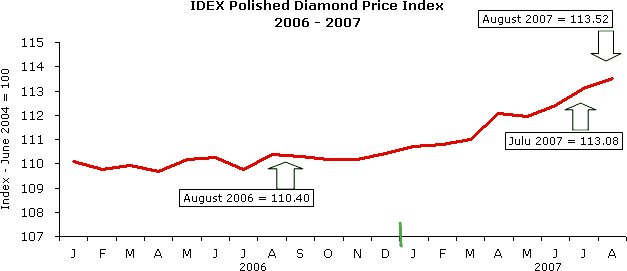
Source: IDEX Online
Month-to-Month Prices Rise 0.4 percent in August
The graph below summarizes month-to-month changes in global diamond prices for the past twenty months, since the beginning of 2006. With the exception of May, polished diamond prices have shown solid gains during almost every month of 2007.
The percentage change comparisons on the graph are based on the daily average prices during the month of all sizes and qualities of polished diamonds. The percentage change shown is based on each month’s average price versus the prior month’s average price (e.g. August 2007 versus July 2007).
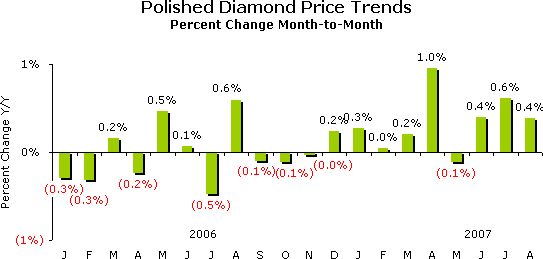
Source: IDEX Online
Year-to-Year Diamond Prices Up 2.8 percent in August
After some softening earlier in the spring, polished diamond prices have continued to show solid gains in August on a year-to-year basis, compared to the same month a year ago. The graph below summarizes year-to-year monthly polished diamond prices for the global market since the beginning of 2006. Clearly, diamond prices reflect a solid uptrend.
Comparisons are based on the daily average prices during the month versus the same month a year ago (e.g. August 2007 versus August 2006). The year-to-year comparison takes into account the seasonality of polished diamond demand and prices.
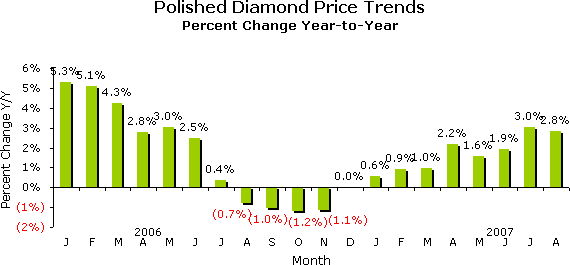
Source: IDEX Online
Prices Stronger At Beginning and End of August
The following graph illustrates the average price of polished diamonds on a day-by-day basis in August. During the middle of the month, there was some seasonal softness in prices related to diamantaires taking holidays. As traders returned to Antwerp and Ramat Gan in late August, prices firmed due to heavier demand, especially for larger, high-quality expensive gemstones.
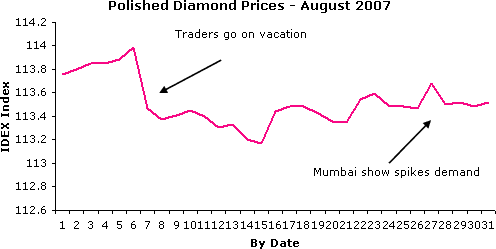
Source: IDEX Online
Diamond Demand Continues to Favor Large Sizes
Retail jewelers say that their customers want larger, better quality diamonds. Recent price trends for polished diamonds confirm this trend though there has been some price inconsistency over the past few months.
The graph below summarizes the price changes for key sizes of polished diamonds on a month-over-month basis: August 2007 versus July 2007. These six stone sizes represent about 30 percent of the trading market by value.
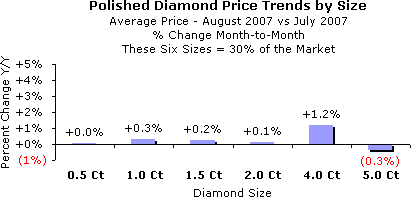
Source: IDEX Online
On a year-to-year comparison, polished diamond prices showed a greater bias: prices for large stones in the four-to-five carat range rose much more sharply than prices of stones in the two-carat range and below. We note, however, that prices for 1.5 carat stones, which represent about 7 percent of the trading market by value, have risen for each of the past three months.
For the “moderate” jewelry customer, a 1.5 carat stone is a “luxury” purchase. This tends to confirm that all major demographic segments of the market are seeking larger stones, relative to their prior purchases.
The graph below summarizes polished diamond prices by key sizes on a year-over-year basis: August 2007 versus August 2006. These sizes represent just under one-third of the market, by aggregate value.
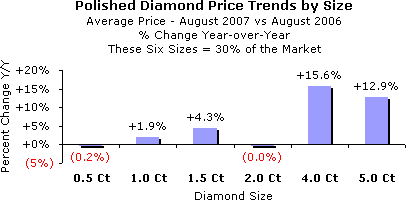
Source: IDEX Online
Diamond Price Forecast: Higher Prices Expected
In prior months, there was uncertainty in our diamond demand and price forecast. Economists were indecisive over whether the global economy would soften moderately or slip into a more serious recessionary environment. Now, however, economists’ forecasts call for the global economy to remain healthy, though there could be some pockets of weaker economic activity in some regions of the world such as Japan. Overall, though, forecasters are now suggesting that the Asian, Indian and European economies will post robust growth. For example, India’s economy grew at a 9.3 percent annual pace for the quarter ended June. The U.S. is expected to post moderate economic growth this year, followed by an acceleration in 2008.
As a result of more favorable economic forecasts, we have raised our outlook again for the U.S. jewelry market during 2007. Earlier this year, we were predicting that jewelry sales might rise at an annual rate of about 3 percent. We are now forecasting a sales increase of 4.4 percent for U.S. jewelry merchants. It is likely that diamond sales will exceed this annual demand pace. In 2006, U.S. diamond sales were up just over 6 percent; it is possible that diamond sales in 2007 could rise by 5-6 percent.
The only losers in this scenario are the retail specialty jewelers. They simply have not been able to raise retail prices fast enough to keep pace with the rising wholesale diamond prices, despite solid demand from consumers. American retailers also suffer from lack of pricing power due to market fragmentation. Thus, while we are now forecasting a relatively robust year for diamonds and diamond jewelry in the U.S. and other world markets, retailers’ gross margins are headed for a modest decline again in 2007. Financial results for the second quarter confirm this trend: a majority of publicly held American jewelers, including Tiffany & Co., have reported a decline in their gross margin.
The IDEX Online Diamond Price Index
The IDEX Online Diamond Price Index is a real-time index derived from actual asking prices in the global diamond industry. The IDEX Online Diamond Price Index objectively reflects price trends as they happen. The Diamond Index and Diamond Drivers were formulated following comprehensive research and analysis of the IDEX Online inventory database, aggregated since 2001. Research and development were conducted in cooperation with Dr. Avi Wohl, Senior Lecturer of Finance at the faculty of Management, Tel Aviv University, Israel.
Additional information is available from IDEX Online Research. The e-mail address is diamondprices at idexonline dot com.